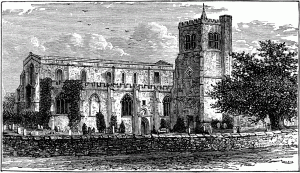 Elstow Abbey was founded in 1078 by the Countess Judith, niece of William the Conqueror. It became one of the richer of the 106 Benedictine nunneries existing at the time and in its hey-day, in the fourteenth century, the building was twice its present size. The end of the Abbey came in 1539, as part of the dissolution of the monasteries.The Abbey was a monastery for Benedictine nuns and was founded c.1075 by Judith, Countess of Huntingdon, a niece of William the Conqueror. It is therefore classed as a royal foundation.
Elstow Abbey was founded in 1078 by the Countess Judith, niece of William the Conqueror. It became one of the richer of the 106 Benedictine nunneries existing at the time and in its hey-day, in the fourteenth century, the building was twice its present size. The end of the Abbey came in 1539, as part of the dissolution of the monasteries.The Abbey was a monastery for Benedictine nuns and was founded c.1075 by Judith, Countess of Huntingdon, a niece of William the Conqueror. It is therefore classed as a royal foundation.The Church, dedicated to St Mary and St Helena, originally extended eastwards for some considerable distance, and contained a central tower, chancel, and Lady chapel.
There were twenty-three nuns in residence besides the abbess, Elizabeth Boyvill, when the monastery was closed in 1539. The land then passed to Edmund Harvey. Following the dissolution, the majority of the church nave was blocked off and retained for parish use. The remainder of the church was demolished after 1580. In 1616 Sir Thomas Hillersdon purchased the remaining monastic buildings and incorporated them into a new house, which itself later became a ruin. The church contains some 15th-century brasses, 17th-century and later tombs and furnishings. Another survivor of the monastery is a small vaulted building on the south side of the church, originally a parlour and now used as a vestry.
Three bays of the church are Norman, (about 1075); the two western bays are of Early English style, about 1225. In 1539, during the suppression, much was lost. By 1580, the east end had been completed, with a west window, and detached tower.
By the time of Elizabeth I, the church itself had been reduced to its present dimensions, becoming the parish church of the village. The six Norman arches that still remain from the original building remind us of the Abbey’s long history of Christian worship.
A water-colour by Thomas Fisher (c.1815) shows a timber-framed north porch. From 1823 to 1828, restoration work was done. Around 1860, a vestry on the north side of the church was demolished.
From 1880 to 1882 restoration work was done, by architect Thomas Jobson Jackson. In 1883 and 1885, the John Bunyan stained glass windows were added in the east wall.
Elstow is famous as the home of John Bunyan . He was baptised in our font in 1628 and as a child and young man he worshiped regularly in this abbey church.



